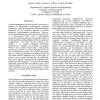Free Online Productivity Tools
i2Speak
i2Symbol
i2OCR
iTex2Img
iWeb2Print
iWeb2Shot
i2Type
iPdf2Split
iPdf2Merge
i2Bopomofo
i2Arabic
i2Style
i2Image
i2PDF
iLatex2Rtf
Sci2ools
FPL
2006
Springer
2006
Springer
Predictive Load Balancing for Interconnected FPGAs
A Field Programmable Gate Array (FPGA), when used as a platform for implementing special-purpose computing architectures, offers the potential for increased functional parallelism over the alternative approach of software running on a general-purpose microprocessor. However, the increasing disparity between the logic speed and density of a state-of-the-art FPGA versus a state-of-the-art microprocessor has already begun to negate the benefits of this increased functional parallelism for all but a limited set of applications. We believe that the solution to this problem is to construct distributed multi-FPGA architectures to aggregate the parallelism of multiple FPGAs. Such a system would require a high-capacity interconnect, and thus we propose arranging the FPGAs onto a scalable direct network. This strategy requires each FPGA to contain an integrated router that must share the logic fabric with the application logic. In this paper, we propose a novel routing technique that can signif...
| Added | 22 Aug 2010 |
| Updated | 22 Aug 2010 |
| Type | Conference |
| Year | 2006 |
| Where | FPL |
| Authors | Jason D. Bakos, Charles L. Cathey, Allen Michalski |
Comments (0)

